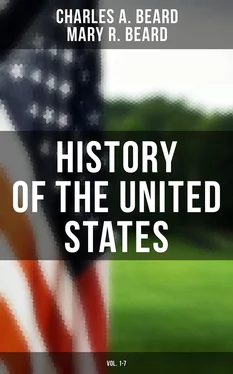C.A.B.
M.R.B.
New York City,
February 8, 1921.
"The Nations of the West" (popularly called "The Pioneers"), designed by A. Stirling Calder and modeled by Mr. Calder, F.G.R. Roth, and Leo Lentelli, topped the Arch of the Setting Sun at the Panama-Pacific Exposition held at San Francisco in 1915. Facing the Court of the Universe moves a group of men and women typical of those who have made our civilization. From left to right appear the French-Canadian, the Alaskan, the Latin-American, the German, the Italian, the Anglo-American, and the American Indian, squaw and warrior. In the place of honor in the center of the group, standing between the oxen on the tongue of the prairie schooner, is a figure, beautiful and almost girlish, but strong, dignified, and womanly, the Mother of To-morrow. Above the group rides the Spirit of Enterprise, flanked right and left by the Hopes of the Future in the person of two boys. The group as a whole is beautifully symbolic of the westward march of American civilization.

Photograph by Cardinell-Vincent Co., San Francisco "The Nations of the West"
PART I. THE COLONIAL PERIOD
Table of Contents
CHAPTER I
THE GREAT MIGRATION TO AMERICA
Table of Contents
The tide of migration that set in toward the shores of North America during the early years of the seventeenth century was but one phase in the restless and eternal movement of mankind upon the surface of the earth. The ancient Greeks flung out their colonies in every direction, westward as far as Gaul, across the Mediterranean, and eastward into Asia Minor, perhaps to the very confines of India. The Romans, supported by their armies and their government, spread their dominion beyond the narrow lands of Italy until it stretched from the heather of Scotland to the sands of Arabia. The Teutonic tribes, from their home beyond the Danube and the Rhine, poured into the empire of the Cæsars and made the beginnings of modern Europe. Of this great sweep of races and empires the settlement of America was merely a part. And it was, moreover, only one aspect of the expansion which finally carried the peoples, the institutions, and the trade of Europe to the very ends of the earth.
In one vital point, it must be noted, American colonization differed from that of the ancients. The Greeks usually carried with them affection for the government they left behind and sacred fire from the altar of the parent city; but thousands of the immigrants who came to America disliked the state and disowned the church of the mother country. They established compacts of government for themselves and set up altars of their own. They sought not only new soil to till but also political and religious liberty for themselves and their children.
The Agencies of American Colonization
It was no light matter for the English to cross three thousand miles of water and found homes in the American wilderness at the opening of the seventeenth century. Ships, tools, and supplies called for huge outlays of money. Stores had to be furnished in quantities sufficient to sustain the life of the settlers until they could gather harvests of their own. Artisans and laborers of skill and industry had to be induced to risk the hazards of the new world. Soldiers were required for defense and mariners for the exploration of inland waters. Leaders of good judgment, adept in managing men, had to be discovered. Altogether such an enterprise demanded capital larger than the ordinary merchant or gentleman could amass and involved risks more imminent than he dared to assume. Though in later days, after initial tests had been made, wealthy proprietors were able to establish colonies on their own account, it was the corporation that furnished the capital and leadership in the beginning.
The Trading Company.—English pioneers in exploration found an instrument for colonization in companies of merchant adventurers, which had long been employed in carrying on commerce with foreign countries. Such a corporation was composed of many persons of different ranks of society—noblemen, merchants, and gentlemen—who banded together for a particular undertaking, each contributing a sum of money and sharing in the profits of the venture. It was organized under royal authority; it received its charter, its grant of land, and its trading privileges from the king and carried on its operations under his supervision and control. The charter named all the persons originally included in the corporation and gave them certain powers in the management of its affairs, including the right to admit new members. The company was in fact a little government set up by the king. When the members of the corporation remained in England, as in the case of the Virginia Company, they operated through agents sent to the colony. When they came over the seas themselves and settled in America, as in the case of Massachusetts, they became the direct government of the country they possessed. The stockholders in that instance became the voters and the governor, the chief magistrate.

John Winthrop, Governor of the
Massachusetts Bay Company
Four of the thirteen colonies in America owed their origins to the trading corporation. It was the London Company, created by King James I, in 1606, that laid during the following year the foundations of Virginia at Jamestown. It was under the auspices of their West India Company, chartered in 1621, that the Dutch planted the settlements of the New Netherland in the valley of the Hudson. The founders of Massachusetts were Puritan leaders and men of affairs whom King Charles I incorporated in 1629 under the title: "The governor and company of the Massachusetts Bay in New England." In this case the law did but incorporate a group drawn together by religious ties. "We must be knit together as one man," wrote John Winthrop, the first Puritan governor in America. Far to the south, on the banks of the Delaware River, a Swedish commercial company in 1638 made the beginnings of a settlement, christened New Sweden; it was destined to pass under the rule of the Dutch, and finally under the rule of William Penn as the proprietary colony of Delaware.
In a certain sense, Georgia may be included among the "company colonies." It was, however, originally conceived by the moving spirit, James Oglethorpe, as an asylum for poor men, especially those imprisoned for debt. To realize this humane purpose, he secured from King George II, in 1732, a royal charter uniting several gentlemen, including himself, into "one body politic and corporate," known as the "Trustees for establishing the colony of Georgia in America." In the structure of their organization and their methods of government, the trustees did not differ materially from the regular companies created for trade and colonization. Though their purposes were benevolent, their transactions had to be under the forms of law and according to the rules of business.
The Religious Congregation.—A second agency which figured largely in the settlement of America was the religious brotherhood, or congregation, of men and women brought together in the bonds of a common religious faith. By one of the strange fortunes of history, this institution, founded in the early days of Christianity, proved to be a potent force in the origin and growth of self-government in a land far away from Galilee. "And the multitude of them that believed were of one heart and of one soul," we are told in the Acts describing the Church at Jerusalem. "We are knit together as a body in a most sacred covenant of the Lord ... by virtue of which we hold ourselves strictly tied to all care of each other's good and of the whole," wrote John Robinson, a leader among the Pilgrims who founded their tiny colony of Plymouth in 1620. The Mayflower Compact, so famous in American history, was but a written and signed agreement, incorporating the spirit of obedience to the common good, which served as a guide to self-government until Plymouth was annexed to Massachusetts in 1691.
Читать дальше














